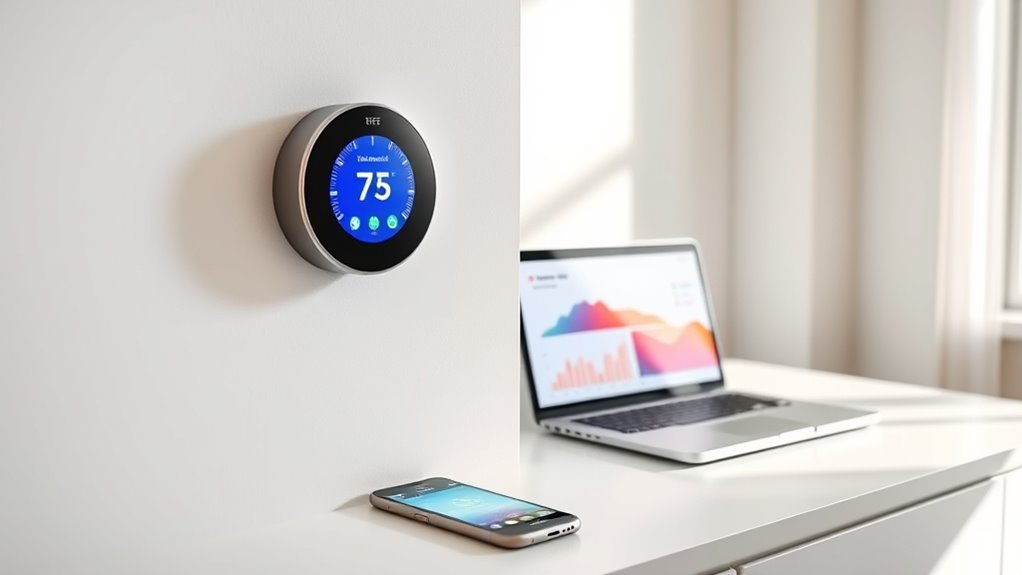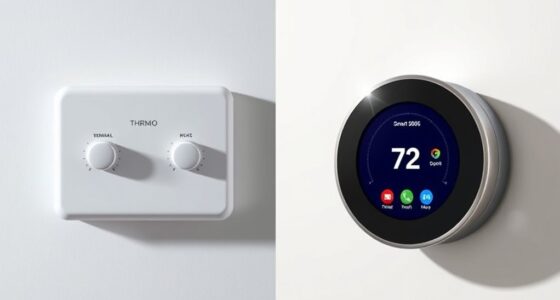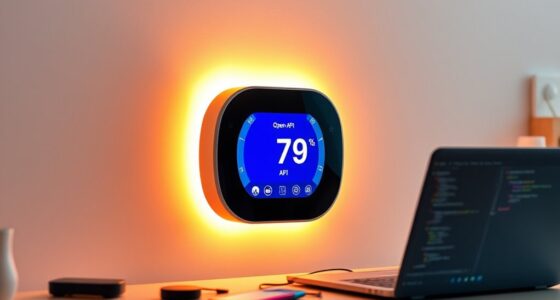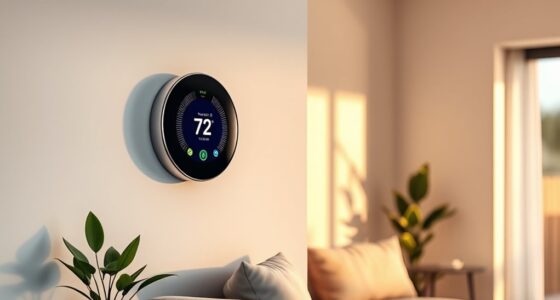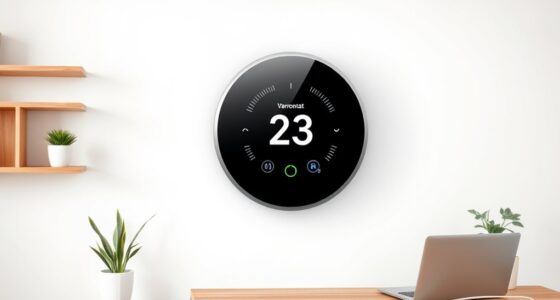When choosing between cloud and local control for your smart thermostat, consider your privacy priorities, as cloud systems store data remotely, potentially risking breaches, while local control keeps data on-site for better security. You also need to weigh responsiveness—local systems offer instant control, whereas cloud solutions rely on internet stability. Maintenance and ongoing costs differ, with cloud updates automatic and local requiring manual work. To find the best fit for your needs, exploring these factors in detail will help you decide wisely.
Key Takeaways
- Cloud control offers automatic updates and remote access, while local control provides instant response and data privacy.
- Latency and internet reliability affect cloud-based thermostats more than local systems.
- Cloud solutions involve ongoing subscription costs; local systems typically require higher upfront investment.
- Local control ensures data stays within premises, reducing privacy concerns compared to cloud storage.
- The choice depends on prioritizing security, responsiveness, budget, and the need for remote management.
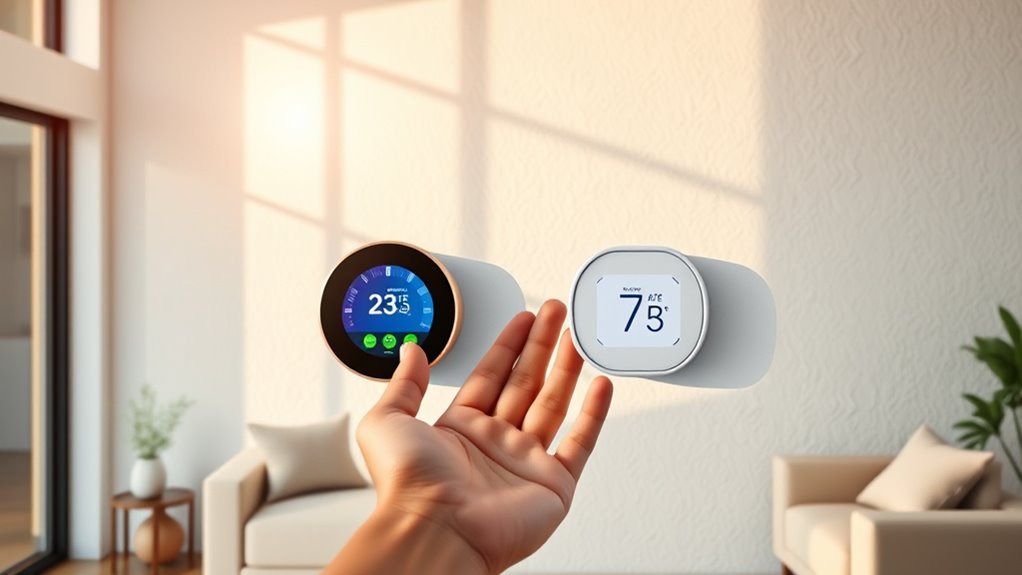
As organizations seek to optimize their operations, choosing between cloud and local control systems becomes a pivotal decision. When it comes to smart thermostats, this choice impacts how you manage data, respond to user needs, and guarantee reliable performance. One key factor to consider is privacy concerns. Cloud systems store your data on remote servers, which can raise worries about unauthorized access or data breaches. If privacy is a top priority, you might prefer local control systems that keep data within your premises, giving you direct oversight and reducing exposure to external threats. However, cloud solutions often offer advanced encryption and security protocols that mitigate these risks, so it’s essential to weigh the level of control you want over sensitive information. Both approaches may involve different methodologies to assess and improve security measures.
Choosing between cloud and local control for smart thermostats hinges on privacy and data security priorities.
Latency issues also play a significant role in this decision. Cloud-based thermostats rely on internet connectivity to process commands and update settings. If your internet connection experiences latency or outages, you could face delays in controlling your thermostat, which might result in uncomfortable temperature fluctuations or system malfunctions. Conversely, local control systems operate directly through on-site hardware, enabling instant responses without the need for an internet connection. This means you get faster, more reliable control, especially in environments where stable connectivity isn’t guaranteed. If real-time responsiveness is vital for your operations, local control offers a clear advantage.
Another aspect to consider is how each system handles updates and maintenance. Cloud systems typically receive automatic updates, ensuring you have access to the latest features and security patches without manual intervention. This convenience can reduce downtime and keep your smart thermostat functioning at its best. However, some organizations prefer to have manual control over updates to avoid unexpected changes that could disrupt operations. On the other hand, local control systems may require manual updates, which can be more labor-intensive but give you full control over when and how changes are implemented.
Cost is also a factor; cloud services usually involve ongoing subscription fees, while local systems often require a higher upfront investment but lower ongoing costs. Your budget and long-term plans will influence which option makes the most sense. Ultimately, your decision hinges on balancing privacy concerns, latency issues, reliability needs, and budget constraints. Both cloud and local control systems have their strengths and limitations, so understanding your specific requirements will help you choose the best solution for your smart thermostat needs.
Frequently Asked Questions
How Does Latency Differ Between Cloud and Local Control?
You’ll notice that local control offers lower network latency and faster response times because commands don’t need to travel over the internet. Cloud control, however, depends on your network’s speed and can experience delays due to internet congestion or server processing times. This means local control generally provides more immediate adjustments, while cloud control might introduce slight lag depending on network conditions.
Can Local Control Operate During Internet Outages?
Yes, local control can operate during internet outages. Since it doesn’t rely on cloud servers, it offers offline operation, allowing you to adjust your thermostat even without an internet connection. However, keep in mind that local control depends on your device’s power supply; if there’s a power dependency issue, the thermostat might not function. Ensuring a reliable power source helps maintain consistent offline operation.
What Are the Security Risks of Cloud-Connected Thermostats?
Think of cloud-connected thermostats as open books—you risk exposing sensitive pages. The primary security risks include data breaches and unauthorized access. If hackers bypass data encryption or exploit weak user authentication, they could manipulate your home’s temperature or steal personal info. Staying vigilant by ensuring strong passwords and secure data encryption helps protect your device. Remember, a lock on the door is only effective if it’s kept locked.
How Do Update Processes Differ for Cloud Vs Local Systems?
You handle update processes differently for cloud and local systems. With cloud-connected thermostats, firmware management involves remote updates via the internet, allowing quick data synchronization and seamless feature enhancements. For local systems, you perform manual firmware updates directly on the device, which may take more time and effort. Cloud updates enable real-time improvements, while local systems require physical access, making the update process more hands-on but potentially more secure.
Is There a Cost Difference Between Cloud and Local Control Options?
Yes, there is a cost difference between cloud and local control options. Cloud-controlled thermostats often have ongoing subscription fees, which can add up over time, but they may offer better energy savings and user convenience through remote access and advanced features. Local control systems usually have higher upfront costs but no recurring fees, making them potentially more cost-effective in the long run for those prioritizing savings and simplicity.
Conclusion
In the battle between cloud and local control, you hold the power. Cloud control offers convenience and seamless updates, but local control gives you unmatched reliability and privacy. Think of it like choosing between a superhero sidekick or going solo—each has its perks, but the right choice depends on what matters most to you. Ultimately, the decision is yours, and it’s not just a small step—it’s like choosing whether to fly or walk through your smart home journey.
